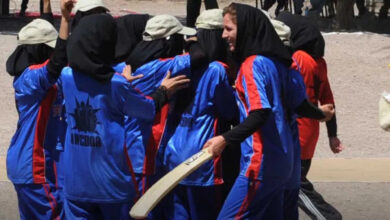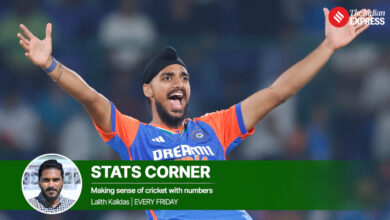French Open: Clay god Rafael Nadal’s exit starts end of unprecedented Roland Garros stronghold | Tennis News

Even as Rafael Nadal went down 3-6, 6-7(5), 3-6 in the first round of the French Open to Alexander Zverev on Monday, he has left the door slightly ajar to return to an arena undoubtedly cast in his image.“I don’t know if this is the last time, I’m not 100% sure. But if it is, I enjoyed it. For me, it is so special to feel the love of the people in the place I love the most,” Nadal said on court after the match. “It’s a big percentage chance that I will not be back here. I have some goals in front (of me), I hope to be on this court for the Olympics, but we will have to wait and see.”
And as Nadal went down to the in-form fourth seed, a brutal first round assignment, he refused to roll over. The king of clay fought till the final moments of him presiding over his kingdom, and left a legacy that will permanently be enshrined in the hory of this tournament.
At the turn of the 21st century, tennis on clay had built a reputation of being a tough, physical, boring grind. It had lost its popularity as the crowd-favourite — usually American — serve-and-volleyers failed to understand its nuances. Baseline grind and pure physicality were not seen as tennis virtues.
Nadal’s emergence made clay cool again. The revolutions per minute (RPM) of the ball, speed of the surface, and altitude of the air began to be analysed in a bid to unravel the mystique around his unflinching success in the Parisian spring. The fascination with the surface, translated into fascination of his dominance on it.
The Spaniard’s two-decade-long career has seen unprecedented highs but the foundation of it has been built on clay, and at its highest place of worship, Roland Garros. On Monday, that remarkable run may have come to an end, but not before his opponent got a taste of how it was born.
The Spaniard’s big lasso-like forehand and bulging biceps may falsely show that he can power through most opponents, but without a massive serve or easy power – both attributes his opponent could rely on to get out of jail – he has never had a weapon that can win him cheap points. Instead, that one quality he has always possessed, that no other surface like clay rewards, is to play through pain and adversity, leaving everything on the court in pursuit of every single point.
We love you too Rafa, and we hope to see you again next year 🧡#RolandGarros pic.twitter.com/7hX4Gw46WE
— Roland-Garros (@rolandgarros) May 27, 2024
Rustiness shows
Even at his current state and age, Zverev would feel the wrath of that quality. Nadal emerged in the second set giving it his all, his forehands finding more zip, his tactics improved, and control of the second set came with an early break. But his rustiness would show; his serve able to do no damage as he would slump while serving for the set, his tendency to make errors at important points leading to the concession of the tiebreak.
Nadal fought, as best he could, but Zverev’s superior form and physical shape towered over him and the match unfolded in the German’s favour from there.
The triumvirate of Nadal, Djokovic and Roger Federer have ruled tennis this century, but each had a separate domain of their own. Federer won eight Wimbledon titles on grass, Djokovic won 10 Australian Opens on the hard courts, but neither could produce the level of domination that Nadal did on clay. Perhaps no player ever will.
The numbers speak for themselves. Nadal has won this tournament 14 times – only three other players have won 14 or more Grand Slam singles titles in total, and only one of them, Djokovic, has won a Major in 14 different years. Monday’s loss was only his fourth at Roland Garros in 116 completed matches, a career win percentage of 96.55% at the toughest tournament in the sport.
But the numbers alone do not tell the full story of how this hallowed site of crushed stone and red brick, of sweat and toil, came to define one of the most captivating sporting figures of the generation gone .
His career was born, and often reborn, on Parisian clay. It was not only where he found his most successful results, but also where he established the most important rivalries in this sport.
It was under the baking sun at Roland Garros where Nadal came up with the strategy to probe the seemingly-impenetrable armour of Roger Federer in the late 2000s. Nadal used his peculiar, spin-heavy lefty forehand to go high and wide into Federer’s backhand wing, repeatedly, to open up the court and take control. This strategy was aped all of his rivals on tour and what drove Federer to reconstruct his backhand, but Nadal was at the forefront of it as he defeated the Swiss in four consecutive French Opens.
Federer-Nadal may be the rivalry that has found the most resonance among fans, but it is Nadal-Djokovic that is the pre-eminent rivalry of Open Era men’s tennis, one that altered the depths to which this sport could be taken. Across 59 meetings, Djokovic holds the narrow edge with 30 wins. He led the way on hard courts, Nadal on clay. But had Nadal’s dominance at Roland Garros not withstood the test of time, not only would there have been little semblance of equality in their rivalry, but the Serb would have established himself as the GOAT before that parlour debate even began.
Djokovic would eventually go on to beat Nadal in Paris twice, but not before he was driven to near madness trying to do so. From unravelling due to surgical precision (2012 final, 2014 final, 2022 semifinal), to suffering crushing beatdowns (2020 final), to career-defining epics (2013 semifinal), Nadal in Paris proved to be the final boss of tennis for Djokovic.
Perhaps how Nadal’s legacy will forever be entrenched into that of this tournament is that he came to endorse all the qualities that are required to excel in clay-court tennis. The brute force and physicality, and his unrelenting competitive spirit, matched up squarely with his humility and sportsmanship, even if they, at times, felt a tad pretentious.
And legacy may be on Nadal’s mind. The Spaniard refused to have a farewell ceremony that the tournament organised for him because he is leaving the door open to return next year – perhaps a tame first-round defeat is not the way he wishes to bow out.
On Monday, however, as match point came, an adoring audience – including the likes of Djokovic, Carlos Alcaraz and Iga Swiatek – stood to their feet in acknowledgement of witnessing hory and gave him a resounding reception. There can be worse farewells than that.







